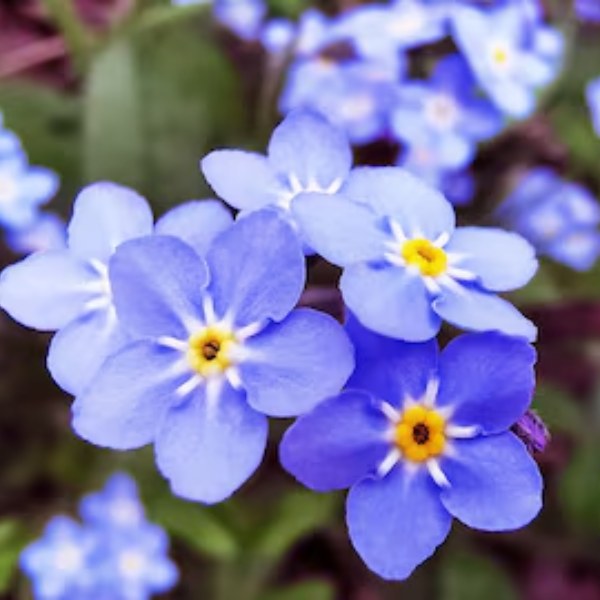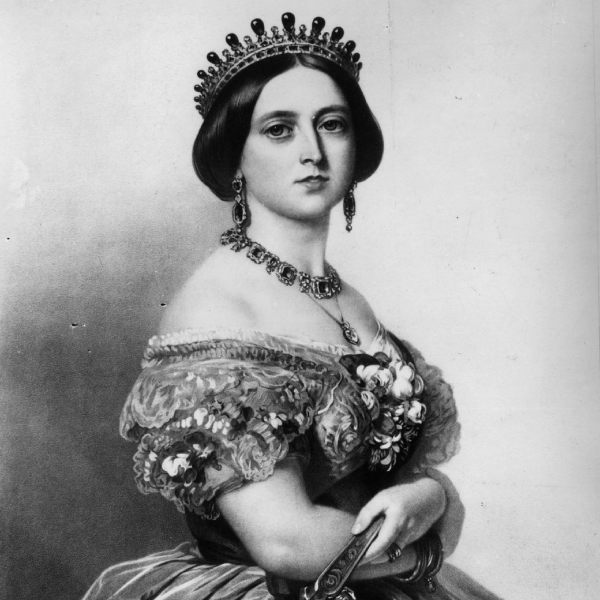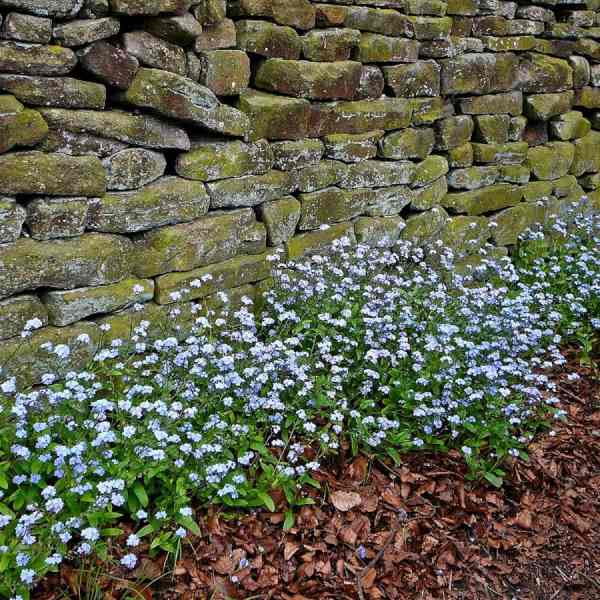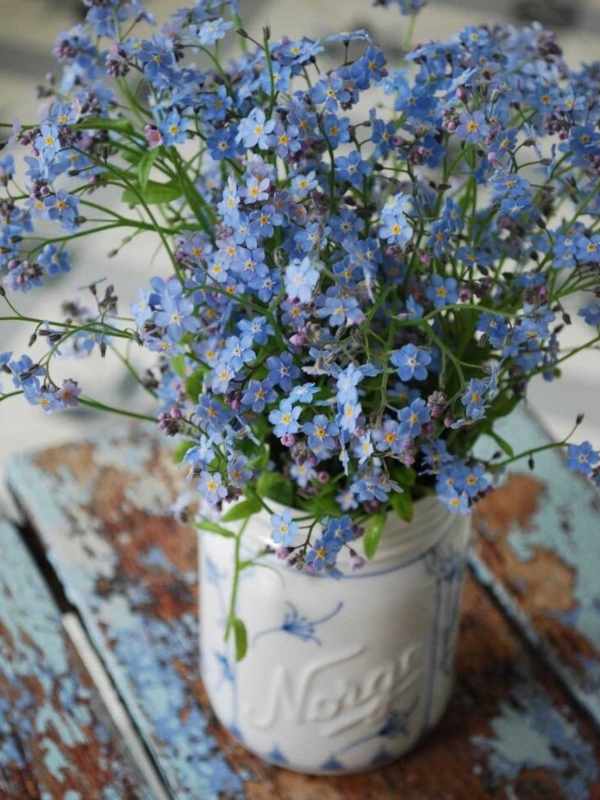Forget Me Not is admired and loved for its lovely blue flowers with dark yellow centers. Despite their tiny size, forget-me-nots have a huge impact as a symbol of love and remembrance. They also act as a stunning addition to any garden or landscape. Whether one chooses to grow these beauties for their looks or meanings, these charming wildflowers can make a lasting impression.
What type of flower is Forget Me Not?
As mentioned above, these are delicate and pretty wildflowers known for their beautiful blue flowers and rich meaning. It is a part of the Boraginaceae family which also houses other famous plants like borage and comfrey.
Diversity: These tiny flowers belong to the genus Myosotis which includes over 150 species that are mostly found in Europe and Asia. However, the natives have been introduced to other parts of the world as well.
Growth habit: Forget-me-nots are hardy perennials or annuals, depending on the species. They vary in size, with some growing up to 2 feet tall while others reach only a few inches in height.

Flowers: They have clusters of tiny, delicate flowers that are normally blue. Some can also be pink or white.
Bloom time: The flowers typically bloom in the spring or summer and can bloom for many weeks, adding a long-lasting source of color and beauty to your garden.
Pollinators: Forget-me-nots are great attractors of bees, butterflies, and other insects which makes them a great addition to any pollinator garden.
Self-seeding: One good thing about these plants is that they are prolific self-seeders, meaning they will reseed themselves in your garden year after year with your extra effort to do so.
Low-maintenance: These plants are very easy to grow and require minimal care, making them a great choice for beginners and busy gardeners.
Hardiness: Forget me not is a hardy plant that can grow in USDA zones 3 to 9. However, the exact hardiness of these delicate plants can depend on the specific species and cultivar.
What is Forget Me Not’s symbolism?
These plants mostly symbolize remembrance, true love, and faithfulness. They are often gifted to loved ones who are leaving on a journey or moving away as a way of expressing a desire to remember each other when they are apart.
Similarly, forget-me-nots are also sometimes associated with homesickness or missing someone who is far away. They are the official flower of the state of Alaska.
Role of forget me not in history
The history of these delicate flowers as a symbol of remembrance and love goes back to medieval Europe. It was believed there that wearing a sprig of flowers would mean that the wearer would never be forgotten by their dear ones.
This tradition was later made popular by the Germanic legend of a knight and his lady, in which the knight throws a bouquet of forget me nots to his love as he falls into a river and drowns. His last words in the story to his beloved were asking her to remember him always, which is exactly what the flowers represent.

They are also related to many other notable figures and events throughout history. They were Queen Victoria’s favorite flowers. She often wore them and even had them on her wedding bouquet. They are also linked with the Freemasons, who have made these flowers as a symbol of their philanthropic work and dedication to charity.
Is Forget Me Not invasive?
These easy-to-grow and delicate plants have some species that are known to be invasive in certain regions.
One of the unique features of these plants is their ability to self-seed and spread easily. This can be a blessing to some and a curse to some, depending on how you see it. On one side, forget-me-nots can grow quickly into large, beautiful patches of flowers that are easy to care for and maintain. However, it also means that sometimes they can grow invasive and take over areas where they are not supposed to.
Should I grow forget me not flowers?
These plants can be a great addition to any garden or landscape for several reasons. Since they are extremely easy to grow and care for, they can be the perfect choice for beginner gardeners or those who have no time.

Also, they grow delicate blue or pink flowers adding a pop of color to any garden or landscape and attracting bees, butterflies, and other pollinators. These easy-going plants are extremely versatile and can be used in different settings, from borders and edging to groundcovers and woodland gardens.
These flowers have a rich cultural history and are associated with love, remembrance, and the lasting power of friendship.
Overall, these plants are a beautiful and meaningful addition to any garden or landscape.
Also, Read Hanging Gardens: Discover 12 Stunning Indoor Plants for Vertical Spaces
Some popular varieties of forget-me-nots
There are many popular species of forget me not, including:
Myosotis sylvatica: This most common species of forget-me-not is also called Woodland Forget-me-not. It is a hardy perennial that is native to Europe and Asia and blooms in the spring season.
Myosotis scorpioides: Also called Water Forget-me-not, this variety is native to Europe and Asia and grows well in wet areas like ponds or river banks.
Myosotis alpestris: This species is native to the Alps and other mountainous regions of Europe. It is a hardy perennial that blooms in the summer.
All these three species are known for their beautiful blue flowers and delicate, airy appearance. They can be used in different settings like wildflower meadows, borders, and rock gardens.
When is the right time to plant forget me not?
- Forget-me-nots can either be planted in the fall or the early spring.
- They can be planted in the fall in places with mild winters.
- In colder climates, plating them in the spring can be the best option as soon as the soil can be worked. This allows the plants to establish a good root system before the hot summer arrives. As an option, you can start seeds indoors 8 to 10 weeks before the last frost date.
- While you can plant these flowers in late spring or early summer, they may not bloom until the next year.
Where to plant forget me not?
- Forget me not love to grow in partially shaded areas that have some good direct sunlight in the morning or evening. In colder climates, they can tolerate full sun.
- Talking about soil, they thrive in moist, well-drained chalk, clay, loam soil, or even sand.
- These delicate plants are often found growing along streams, ponds, and other water bodies. In homes, they can be planted in containers or used as border plants in shaded garden beds. Here we give you some tips for adding them to your garden:
- Plant them in borders: These plants can create a stunning border around other plants or along a pathway, adding a splash to your beautiful garden and attracting pollinators like bees and butterflies.
- Keep them in rock gardens: Forget-me-nots are small and delicate and make a great addition to rock gardens. They can fill gaps between rocks and give them a natural look.
- Plant them in containers: Forget-me-nots can be planted in containers and can be kept in your patio and deck.

- Combine with other plants: When combined with other spring-blooming plants like tulips, daffodils, and crocuses, they do not look great. They can also be combined with other perennials like hostas and ferns.
- Let them be: You can let these plants neutralize and spread throughout the garden. If you have a large area and you’re wondering what to do, forget-me-nots can be great options to fill in.
How to plant forget me not?
- Choose a cool and moist location in partial shade.
- The soil must be 6-8 inches deep and any rocks or debris must be removed. Add organic matter like compost or well-rotted manure to the soil and mix well.
- Scatter the seeds thoroughly after planting and lightly press them into the soil.
- Water the seeds after planting and keep the soil consistently moist until they germinate. However, you should not overwater it.
Also, Read Container Gardening Made Easy: 10 Sun and Shade-Loving Low-Maintenance Plants
